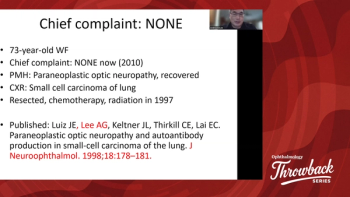
- Ophthalmology Times: September 1, 2020
- Volume 45
- Issue 14
FAF shedding light on patterns related to disease chronicity in CSC
Study designed to identify patterns in abnormalities and differences characteristic of disease.
This article was reviewed by Seung-Young Yu, MD, PhD
The patterns of central serous chorioretinopathy (CSC) visualized by fundus autofluorescence (FAF), a noninvasive imaging method, can help clinicians determine a treatment plan based on disease chronicity.
This was the finding of a study designed to identify patterns in the FAF abnormalities and differences that are characteristic of acute and chronic forms of the disease in this patient population.
Related:
Previously, no objective standard has been available to evaluate chronicity, and patient evaluation depended on patient recall of their symptom duration.
“The acute form of [CSC] generally resolves spontaneously, with a return to almost normal visual acuity,” according to Jisang Han, MD, first author of the study, who emphasized the importance of differentiating between the 2 forms to provide appropriate treatment. “However, the chronic form of this disease often is associated with visual acuity decline and atrophic and degenerative changes of the retina and retinal pigment epithelium.”
The study and findings
Han and colleagues, led by senior author Seung-Young Yu, MD, PhD, conducted a cross-sectional observational study that included 126 eyes of 118 patients (100 men, 18 women; mean age, 46.5 years) diagnosed with CSC between December 2006 and April 2012.
The patterns seen on FAF images were analyzed using spectral-domain optical coherence tomography (SD-OCT) (Spectralis HRA + OCT, Heidelberg Engineering) combined with confocal scanning laser ophthalmoscopy (Heidelberg Retina Angiograph 2; Heidelberg Engineering).
The investigators defined an abnormal FAF signal as one that either increased or decreased with a normal background FAF, Yu recounted.
Related:
Specifically, a blocked FAF pattern was one with no changes or uniform changes in decreased autofluorescence in the presence of subretinal fluid (SRF).
Mottled FAF was a pattern with a grainy or coarse area of increased FAF compared with a normal background. Hyper-FAF was a pattern with an increased FAF signal compared with an area outside of the lesion.
Finally, hyper-/hypo-FAF was a pattern with mixed hyper- and hypoautofluorescence, and descending tract FAF was a pattern with downward-leading swaths of decreased autofluorescence that originated in the posterior pole and extended beyond the inferior arcade, Yu explained.
The authors reported their findings in Retina.1
The 5 FAF patterns were identified in 38.9% (blocked), 8.7% (mottled), 31.0% (hyper), 13.5% (hyper/hypo), and 8.0% (descending tract) of cases. The respective symptom durations were 7.8, 28.3, 42.5, 174.4, and 163.8 days.
The mean visual acuity was 0.32 logarithm of the minimum angle of resolution.
Related:
The visual acuity in the group with blocked FAF, which had the shortest duration of the 5 groups, was significantly (P = .011) better compared with the others; all eyes in the blocked group had an intact ellipsoid zone (EZ).
The EZs in the blocked, mottled, and hyper-FAF groups were more pronounced on SD-OCT images compared with those in the hyper-/hypo-FAF and descending tract groups, the authors found.
In commenting on their findings, the investigators said, “The decreased autofluorescence is most likely related to the blockage of the FAF signal by the SRF.”
The investigators explained that blocked FAF is thought to be present in early CSC. Compared with blocked FAF, mottled FAF—with its diffusely speckled hyperautofluorescence—is likely related to a longer duration of SRF.
In the eyes with hyper-FAF, the symptom duration was longer compared with eyes with mottled FAF. Over time, hypo-FAF was seen in the areas with hyper-FAF, and the 2 forms coexisted.
The investigators also observed that in patients with chronic disease, there were varying degrees of atrophy that included broader areas of geographic atrophy in the macula and tracts of fluid descending downward as the result of gravity.
These tracts, they noted, generally are hyperautofluorescent but progress to hypofluorescence with damage to the retinal pigment epithelial cells that are in contact with the SRF.
In commenting on visual acuity, the investigators pointed out that the better visual acuity in the blocked group “suggested that visual acuity could be maintained with an intact [external limiting membrane] and EZ, because the serous retinal detachment duration is shorter and less perturbed due to the closed SRF. The hyper-/hypo- and descending tract groups showed the least favorable visual prognosis.”
Investigators explained that the EZ may become disrupted with increasing chronicity of the disease and that vision decreased in association with the disrupted EZ.
Based on these findings, the investigators concluded that FAF imaging is useful in the diagnosis of CSC and can help in treatment planning.
“FAF patterns in CSC are helpful when considering the timing of treatment and predicting the disease status,” they concluded.
--
Seung-Young Yu, MD, PhD
e:[email protected]
Seung-Young Yu, MD, PhD, is from the Department of Ophthalmology, Kyung Hee University Hospital, Seoul, Republic of Korea. Jisang Han, MD, is from the Department of Ophthalmology, Kangbuk Samsung Hospital, Sungkyunkwan University School of Medicine, Seoul, Republic of Korea. No authors had a financial or conflicting interest in this subject matter.
--
Reference
1. Han J, Cho NS, Kim K, et al. Fundus autofluorescence patterns in central serous chorioretinopathy. Retina. 2020;40(7):1387-1394. doi:10.1097/IAE.0000000000002580
Articles in this issue
about 5 years ago
Improve patient comfort with intravitreal injectionsabout 5 years ago
Stem cells for dry AMD with GA show promise in early studyabout 5 years ago
Ophthalmology taking the treatment conversation onlineabout 5 years ago
Astigmatism management software proving to be accurate, preciseabout 5 years ago
Examining ocular allergy, quality of lifeabout 5 years ago
Improving surgical safety, efficiency, and outcomes for patientsabout 5 years ago
IOL offering treatment options for ophthalmologistsabout 5 years ago
Unproductive worry: Conquering fear during a pandemicabout 5 years ago
Are posterior corneal curvature changes culprit in hyperopic shifts?Newsletter
Don’t miss out—get Ophthalmology Times updates on the latest clinical advancements and expert interviews, straight to your inbox.


















































.png)


